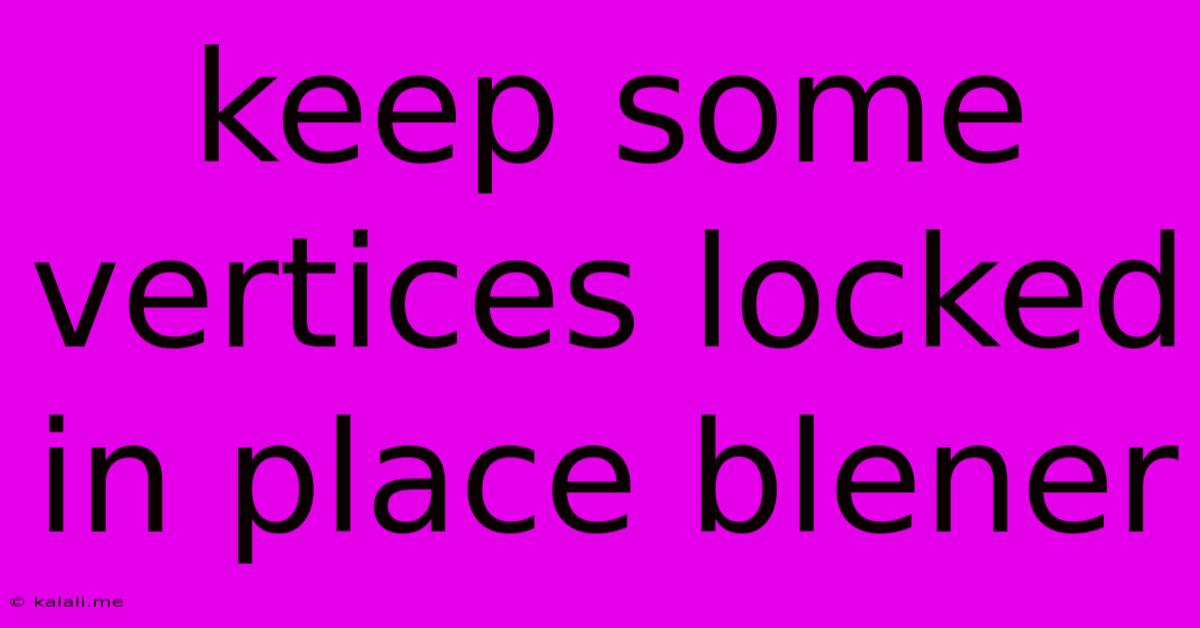Keep Some Vertices Locked In Place Blener
Kalali
Jun 04, 2025 · 3 min read

Table of Contents
Keeping Some Vertices Locked in Place in Blender: A Comprehensive Guide
This article provides a detailed guide on how to keep specific vertices locked in place while modeling in Blender. This is a crucial technique for maintaining precise control and preventing accidental modifications to critical parts of your model. We'll explore various methods, from simple workarounds to advanced techniques using vertex groups and constraints. This ensures you can achieve professional-level precision in your 3D modeling.
Why Lock Vertices?
Locking vertices is essential for various reasons, especially during complex modeling tasks:
- Maintaining Symmetry: Preserving perfectly mirrored sections of your model.
- Precise Detailing: Preventing accidental movement of crucial points during sculpting or editing.
- Reference Points: Keeping certain vertices fixed to act as anchors for other manipulations.
- Efficient Workflow: Avoiding tedious corrections after accidentally moving critical vertices.
Methods for Locking Vertices in Blender
Blender doesn't have a direct "lock vertex" function. However, several effective methods achieve the same result:
1. Using Vertex Groups
This is the most powerful and flexible method for locking vertices.
- Create a Vertex Group: Select the vertices you want to keep locked and assign them to a new vertex group (e.g., "LockedVertices").
- Weight Painting (Optional): For more control, use weight painting to assign different weights to vertices within the group. A weight of 1.0 means the vertex is fully part of the group; 0.0 means it's not.
- Using the Vertex Group in Modifiers: Add a modifier (like an Armature modifier or a Lattice modifier) to the object. In the modifier's settings, you can usually link the modifier's influence to your "LockedVertices" vertex group. Adjust the modifier's influence to your needs, often using the weight values you assigned. The vertices in your group will be mostly unaffected by this modifier's transform.
This method is ideal for complex models where you need precise control over which vertices are affected by transformations or modifiers. It allows for subtle adjustments and is easily reversible.
2. Duplicating and Hiding
A simpler method for less complex situations:
- Duplicate the Vertices: Select the vertices you want to keep locked and duplicate them (Shift+D).
- Separate the Selection: Separate the duplicated vertices into a new object (P > Selection).
- Hide the Original Vertices: Hide the original object, leaving only the locked vertices visible.
This method is quick and easy but less flexible. You'll need to manage two separate objects. It's best suited for temporary locking during specific editing stages.
3. Parent to an Empty
This is useful for preserving the position of a group of vertices relative to a central point.
- Create an Empty: Add an empty object to your scene.
- Select the Vertices and the Empty: Select the vertices you want to lock (in Edit Mode) and then select the empty object (in Object Mode).
- Parent the Vertices: Parent the selected vertices to the empty object (Ctrl+P > Object).
The vertices will now move with the empty object but can be independently manipulated by transforming the empty. Again, it's less flexible than vertex groups, especially when you need to manipulate other parts of the model without affecting the locked section.
Choosing the Right Method
The best method depends on the complexity of your model and the specific task at hand. For simple tasks, duplicating and hiding may suffice. For complex scenarios requiring flexibility and precision, using vertex groups with modifiers offers superior control. Parenting to an empty is a good alternative when maintaining relative position is the primary goal. Understanding these techniques allows for a more efficient and precise workflow, elevating the quality of your Blender models significantly.
Latest Posts
Latest Posts
-
The Multi Part Identifier Cannot Be Bound
Jun 06, 2025
-
How Do You Put Out A Lithium Battery Fire
Jun 06, 2025
-
Large Cardinals Provide Us With Generic Absoluteness
Jun 06, 2025
-
Learning Sequences From Knowledge In Fuzzy Sequential Pattern Mining
Jun 06, 2025
-
Should I Use If Exists And If Not Exists
Jun 06, 2025
Related Post
Thank you for visiting our website which covers about Keep Some Vertices Locked In Place Blener . We hope the information provided has been useful to you. Feel free to contact us if you have any questions or need further assistance. See you next time and don't miss to bookmark.